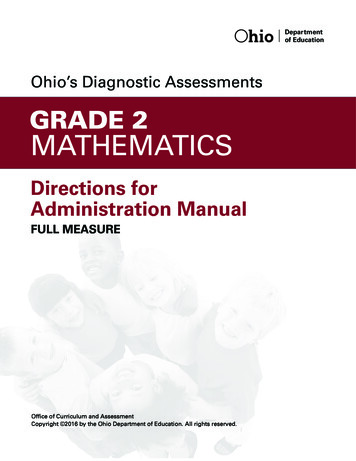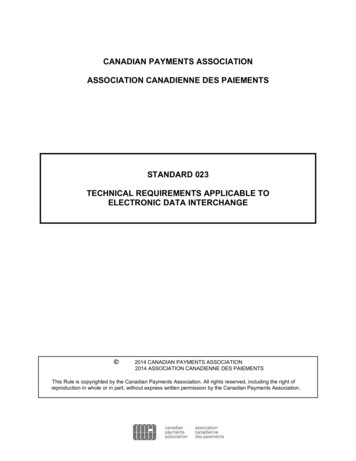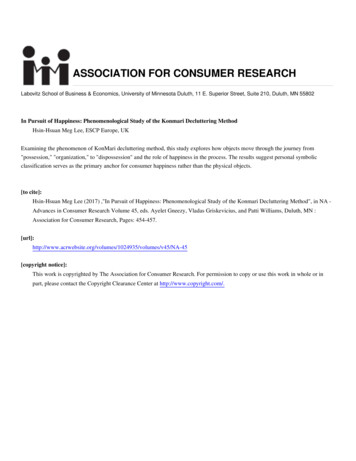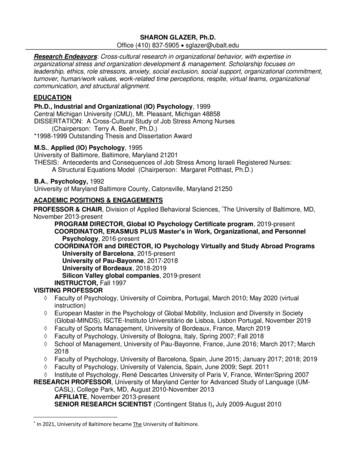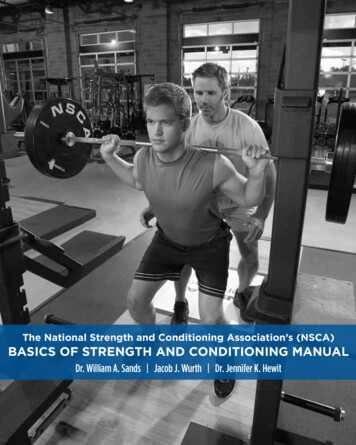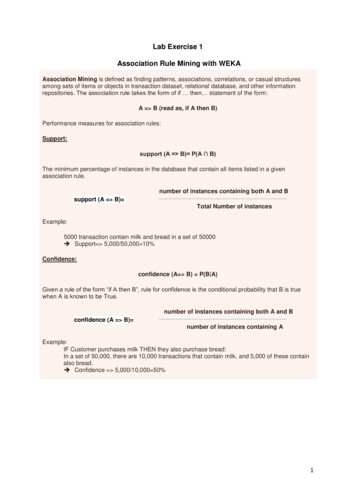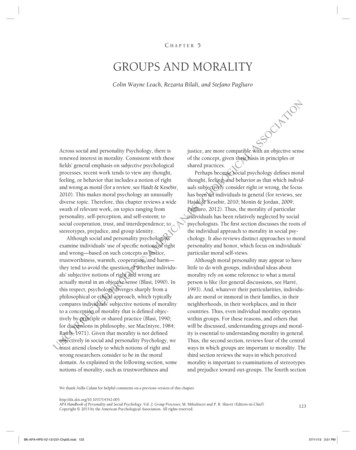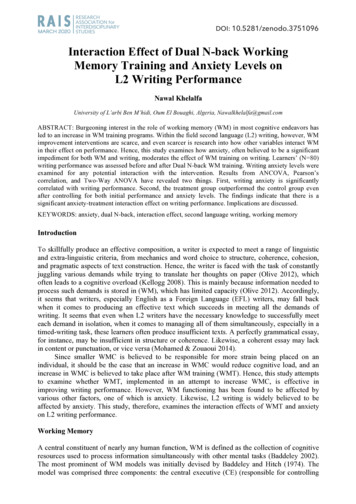
Transcription
RA I SMARCH 2020RESEARCHASSOCIATION forINTERDISCIPLINARYSTUDIESDOI: 10.5281/zenodo.3751096Interaction Effect of Dual N-back WorkingMemory Training and Anxiety Levels onL2 Writing PerformanceNawal KhelalfaUniversity of L’arbi Ben M’hidi, Oum El Bouaghi, Algeria, Nawalkhelalfa@gmail.comABSTRACT: Burgeoning interest in the role of working memory (WM) in most cognitive endeavors hasled to an increase in WM training programs. Within the field second language (L2) writing, however, WMimprovement interventions are scarce, and even scarcer is research into how other variables interact WMin their effect on performance. Hence, this study examines how anxiety, often believed to be a significantimpediment for both WM and writing, moderates the effect of WM training on writing. Learners’ (N 80)writing performance was assessed before and after Dual N-back WM training. Writing anxiety levels wereexamined for any potential interaction with the intervention. Results from ANCOVA, Pearson’scorrelation, and Two-Way ANOVA have revealed two things. First, writing anxiety is significantlycorrelated with writing performance. Second, the treatment group outperformed the control group evenafter controlling for both initial performance and anxiety levels. The findings indicate that there is asignificant anxiety-treatment interaction effect on writing performance. Implications are discussed.KEYWORDS: anxiety, dual N-back, interaction effect, second language writing, working memoryIntroductionTo skillfully produce an effective composition, a writer is expected to meet a range of linguisticand extra-linguistic criteria, from mechanics and word choice to structure, coherence, cohesion,and pragmatic aspects of text construction. Hence, the writer is faced with the task of constantlyjuggling various demands while trying to translate her thoughts on paper (Olive 2012), whichoften leads to a cognitive overload (Kellogg 2008). This is mainly because information needed toprocess such demands is stored in (WM), which has limited capacity (Olive 2012). Accordingly,it seems that writers, especially English as a Foreign Language (EFL) writers, may fall backwhen it comes to producing an effective text which succeeds in meeting all the demands ofwriting. It seems that even when L2 writers have the necessary knowledge to successfully meeteach demand in isolation, when it comes to managing all of them simultaneously, especially in atimed-writing task, these learners often produce insufficient texts. A perfectly grammatical essay,for instance, may be insufficient in structure or coherence. Likewise, a coherent essay may lackin content or punctuation, or vice versa (Mohamed & Zouaoui 2014).Since smaller WMC is believed to be responsible for more strain being placed on anindividual, it should be the case that an increase in WMC would reduce cognitive load, and anincrease in WMC is believed to take place after WM training (WMT). Hence, this study attemptsto examine whether WMT, implemented in an attempt to increase WMC, is effective inimproving writing performance. However, WM functioning has been found to be affected byvarious other factors, one of which is anxiety. Likewise, L2 writing is widely believed to beaffected by anxiety. This study, therefore, examines the interaction effects of WMT and anxietyon L2 writing performance.Working MemoryA central constituent of nearly any human function, WM is defined as the collection of cognitiveresources used to process information simultaneously with other mental tasks (Baddeley 2002).The most prominent of WM models was initially devised by Baddeley and Hitch (1974). Themodel was comprised three components: the central executive (CE) (responsible for controlling
RAIS Conference Proceedings, March 30-31, 202068attention), the phonological loop (responsible for processing language), and the visuospatialsketchpad (responsible for processing visual and spatial stimuli). Baddeley’s (2000) revisedmodel added a fourth component, the episodic buffer (an interface between the othercomponents) (Baddeley 2012). The model has been adopted as a theoretical framework forresearch in a wide range of fields, including language acquisition and learning. Numerous studieshave revealed that WM is a significant contributor to first language (L1) acquisition (Baddeley,Gathercole & Papagno 1998) as well as L2 learning (Linck, Osthus, Koeth & Bunting 2014);Skehan 2002).Dual N-backWith proliferating research on WM over the last decade also came proliferating attempts atenhancing WMC and consequently improving performance on various cognitive tasks. The mostcommonly-employed WMT program today is the dual N-back task, adapted in 2003 by SusanneJaeggi and her colleagues from Kirchner’s (1985) single N-back task (Jaeggi et al. 2003). In thetask, two stimuli, one visual and one auditory, are presented simultaneously in series, both to beremembered together. These two N-back tasks, when performed simultaneously, were originallyclaimed to improve WMC, which in turn is believed to be transferred to other, untrained,cognitive tasks such as fluid intelligence after eight weeks of training (Jaeggi et al. 2008). Suchclaims raised a wave of controversy on the effectiveness of dual N-back training which has yet tobe settled today. While some studies on WMT have reported only near transfer effects, othershave reported far transfer effects, and others have reported no effects (Soveri, Antfolk, Karlsson,Salo & Laine 2017). To the knowledge of the researchers, no studies are available in the literaturewhich examine the far-transfer effects of the training program on L2 writing performance.Working Memory and L2 WritingVarious empirical as well as theoretical studies have also been carried out in attempt to establisha relationship between the two constructs (McCutchen, Covill, Hoynes, & Mildes, 1994; Kellogg2008; Hoskyn & Swanson 2003; Vanderberg & Swanson 2007). Kellogg (1996) asserted thatevery writing process is dependent on WM except the executing sub-process, mainly due to itspurely physical (and mostly automatic) rather than cognitive nature. In studying the significanceof WMC in writing, researchers have focused on potential cognitive overload. The demandsplaced on the writer to translate her thoughts into written form consumes a significant amount ofWM resources, so much that the resources available for planning and other processes are limited;hence, performance is likely hindered (Bourdin & Fayol 1994). This is because the writer is facedwith numerous other demands: 1) making sure her spelling, handwriting, and grammar are up tostandards, 2) trying to predict and meet the expectations of the readers as well constantly makingsure she is not deviating from the task or the prompt, 3) juggling any newly-generated orunexpected ideas, in which case she has to make the decision of either delaying this newlygenerated information until she has finished her current task or finishing her current task at theexpense of maybe losing fresh ideas. Other demands, which may be seen as constraints, areexternal factors such as time management or environmental distractors. All of thesesimultaneously being juggled are the responsibility of the WM system, a system which is alreadylimited in both storage and processing capacity (Olive 2012).Accordingly, all of this seems to be even truer for those writing in a non-native language.These learners are not only faced with all of the cognitive load and strain already associated withwriting, but they are also faced with the added strain of managing it in a language foreign to them.They may put forth more effort than natives when retrieving lexical items or generatinggrammatically or stylistically effective sentences or paragraphs. Sometimes they may be faced withcultural barriers, which may prevent them from effectively writing to a certain audience. Lu (2015)stated that “language learners, when they are writing in their L2, they must use part of their cognitive
RAIS Conference Proceedings, March 30-31, 202069resources to focus on the language so that other functions, such as higher-order functions fororganization and discourse cannot be engaged at full capacity” (p. 176).The Role of AnxietyAccording to Eysenck and Calvo’s (1992) Processing Efficiency Theory, worry and anxiety lead to adecrease in WM storage and processing capacity. This is because worry leads to a pre-occupationwith failure or being judged, and this preoccupation consumes a significant amount of already-limitedresources of WM, leaving less resources and hindering processing and storage capacity for devoted tothe task at hand. The debilitative role of anxiety in WM is supported by numerous researchers(Eysenck & Calvo 1992; Mitte 2008). Moran (2016) conducted a meta-analysis of 177 sampleswhich includes 22,061 participants and found a significant negative correlation between anxiety andWMC. When a particular task relies on WM, under certain levels of anxiety, WMC or processing ishindered by anxiety and hence the task is as well. The role of anxiety has also been found to play adebilitative role in L2 writing (Al Asmari 2013; Lee & Krashen 2002; Rezaei, Jafari, & Younas2014).Based on the evidence available in the literature, this study set out to test whether anxietyfunctions as a significant moderator in the relationship between WMT and L2 writingperformance. It set out to test whether WMT affects L2 writing performance and whether anxietylevels alter, or interact with, the effect of the intervention on L2 writing performance.Accordingly, the aim of this study is two-fold. First, it aims to assess the extent of the far-transfereffects, if any, of Dual-N back WMT program on L2 writing performance. Second, it aims toexamine any potential anxiety-treatment interaction effects on writing performance.The following research questions were adopted:1.2.3.Is there a main treatment effect of dual N-back WMT on EFL learners’ writing performance?Is EFL learners’ anxiety levels correlated with their writing performance?Is there a significant anxiety-treatment interaction effect on L2 writing performance?MethodParticipantsThe sample consists of 80 Algerian university students enrolled as second year students ofEnglish as a Foreign Language (EFL) at L’arbi Ben M’hidi University in Oum El Boughi,Algeria. The researcher assigned 42 participants to the control group and 38 to the experimentalgroup. Of the total sample, 15 are male and 65 are female. This predominance of females overmales reflects the same predominance across the whole faculty and department.Measurement toolsThe researcher adapted Cheng’s (2004) self-report scale, the Second Language Writing AnxietyInventory (SLWAI), for measuring writing anxiety. The questionnaire contains 22 itemsanswered on a 5-point Likert scale, with 0 denoting ‘strongly disagree’ and 4 denoting ‘stronglyagree’. The inventory’s original internal consistency yielded a Cronbach’s alpha of .91 (Cheng2004). Results from this study yielded an alpha of .92, indicating strong internal consistency.Writing performance was operationalized using a writing prompt to which students wereexpected to respond in the form of an essay. They were then evaluated based on a 30-poimtevaluation rubric which was divided into five categories of writing: organization, development,word choice, sentence structure, and mechanics. Two raters, both doctoral candidates in English,evaluated the essays and discussed cases of disagreement until agreement was reached. Theresearcher ran an inter-rater reliability analysis using the inter-class correlation coefficient, whichyielded a coefficient of .94, indicating strong inter-rater reliability.
RAIS Conference Proceedings, March 30-31, 202070The interventionThe intervention for this study is WMT, applied via the Dual N-back program (Jaeggi et al.2003). The task is typically completed using some form computer program; in this intervention,the subjects completed the task mostly on their mobile devices, some on their phones and otherson their tablets or iPads. In the game, the participants were presented with a large square which isdivided into nine smaller inner squares (three rows and three columns of inner squares. All of thesquares are active with the exception of the middle square. At each position one of the squaresflashes (a visual stimuli) and, at the same time, a letter is uttered. Each participant wasresponsible for remembering both stimuli n positions back so that they indicate when the currentposition matches. The current position may match in terms of only one stimulus (either visual orauditory), or it can match in terms of both stimuli. Subjects were responsible for stating eithercase. As each subject matches each level, they progress to the next level, in which the nincreases; for instance, from two positions back to three then four positions back, and the gamebecomes more difficult. At the end of every session, they are provided with the statistics for theirperformance.Participants were provided with a grid to fill out at each trial, reporting scores for position,for sound, and the total score. Since significant effects of dual N-back WMT have been reportedafter 3 weeks of training (a total of eight hours of training) (Jaeggi et al. 2008), subjects weregiven more than 8 hours total throughout the semester to complete the tasks in class, and thosewho failed to do so were asked to work at home. At the end of the intervention, the researcherscollected their grids and screenshots of the graphical representations of what they had completed,which also included their scores and progress throughout all of the sessions. All procedures anddata were applied and collected, respectively after compliance from all the subjects. They had fullknowledge and provided full consent of their participation in the experiment.Results and DiscussionResults from the preliminary descriptive statistics revealed that pre-test writing scores rangedfrom 3 to 21.5 with a mean (M) of 12.40 and a standard deviation (SD) of 4.32, from a possiblescore of 30. Anxiety scores ranged from 4 to 58 (M 26.47, SD 12.84) out of 60, and post-testwriting scores ranged from 8 to 21.5 (M 13.56, SD 3.34). The researcher also ran tests forassumptions of parametric testing (in this case analysis of covariance, Pearson’s correlationcoefficient, and two-way ANOVA). The boxplots indicate that data for the three variables do notcontain any outliers, and results from Kolmogorov-Smirnov’s test for normality indicate a normaldistribution of data for pre-test writing scores (D (72) .07, p .533), post-test writing scores (D(72) .08, p .062), and anxiety scores (D (72) .089, p .147). Finally, Levene’s test forequality of variances indicates equal variances across groups for pre-test writing scores (F (1, 78) 1.11, p .295), for post-test writing scores (F (1, 78) .262, p .297) and for anxiety scores (F(1, 70) .264, p .609).Results from ANCOVA (presented in Table 1) have revealed that there is a statisticallysignificant difference between the two groups in their final writing score after controlling fortheir initial scores, F (1,77) 9.016, p .004. To gain a better understanding of how the covariate(pre-writing scores) affected the original means of the two groups, the adjusted means werereferred to (M 12.76 for the control and M 14.44 for the experimental group). Results from thePearson Correlation analysis indicate that a L2 writing anxiety is statistically and negativelycorrelated with L2 writing performance at the .01 level (r (72) .47, p .000). Hence, higheranxiety levels are associated with lower writing performance and vice versa.
RAIS Conference Proceedings, March 30-31, 202071Table 1. ANCOVA results controlling for pre-test scoresTests of Between-Subjects EffectsDependent Variable: Post-writingSourceType III Sum ed ModelCorrected TotalSig.PartialSquareddf Mean SquareEtaa. R Squared .467 (Adjusted R Squared .454)Finally, after running Pearson Correlation analysis, the researcher tested for a treatment-anxietyinteraction effect using two-way ANOVA. As Table 2 summarizes, the treatment itself (representedby the ‘group’ row) did not yield a significant effect (F (1, 72) 1.438, p .235). However, havingalready tested the effect of the treatment when controlling for pre-test scores (via ANCOVA) andestablishing an association, what remains of major importance is whether anxiety has interactedwith the treatment and altered its effect on writing performance. Statistics for treatment-anxietyinteraction are presented in the bold row (group * anxiety), which indicate that there was asignificant treatment- anxiety interaction effect (F (3,72) 3.028, p .036). Therefore, anxietyseems to interact with WM training in its effect on writing performance. Figure 1 is a graphicalrepresentation for a better understanding of the nature of the interaction effect.Table 2. Two-way ANOVA results for interaction effectTests of Between-Subjects EffectsDependent Variable: Post-writingSourceType IIISum of SquaresdfMeanSquareFSig.Partial 438.235.022Anxiety118.402339.4674.610.006.178Group * 61Total14016.00072785.77871Corrected ModelCorrected Totala. R Squared .303 (Adjusted R Squared .226)
RAIS Conference Proceedings, March 30-31, 202072As the figure shows, anxiety levels have been categorized and transformed into nominal scale forthe convenience of the statistical test. Those with anxiety levels from 0-14 were categorized as‘low anxiety’, those with scores of 15-29 were placed under the category of low-mid anxiety,those with scores of 30-44 were categorized as mid-high anxiety, and those with scores of 45-60have the highest level of anxiety.Figure 1. Graphical representation of treatment-anxiety interactionThe graphical representation allows for the comparison of the four anxiety levels simultaneouslywith respect to the two groups and writing achievement. It seems that the higher the anxietylevels of individuals, the lower their writing scores (estimated marginal means). This is evidentwhen looking at the four lines; the bottom line, where the lowest performers lie, represents thehighest level of anxiety while the top line, where the highest performers lie, represents the lowestlevel of anxiety. Moreover, when anxiety is contextualized against the two groups, it is evidentthat within each level of anxiety the experimental group outperformed the control group exceptfor one level (low-mid anxiety). Hence, although the experimental group seemed to haveoutperformed the control group overall, there seems to be a huge variation in performance of bothgroups among those with different anxiety levels.The first research question, which sought to determine whether an intervention of Dual Nback WMT affected L2 writing performance, was answered via ANCOVA, controlling for thecovariate pre-test writing scores. Results revealed that, after controlling for their original writingscores, those of the experimental group performed significantly better than those of the controlgroup, indicating that WMT does lead to far-transfer effects. These findings are in parallel withfindings from Jaeggi et al. (2008). Also, these results suggest that WMT does have some effecton writing performance, particularly L2 writing. These findings seem to support Kellogg’s (1996)theoretical model of how WM significantly contributes to writing. Furthermore, the findingsseem to be in parallel with those of Linck, Osthus, Koeth, and Bunting, (2014), who found thatWM had contributed to aspects of L2 learning and Vanderberg and Swanson (2007)
timed-writing task, these learners often produce insufficient texts. A perfectly grammatical essay, for instance, may be insufficient in structure or coherence. Likewise, a coherent essay may lack in content or
